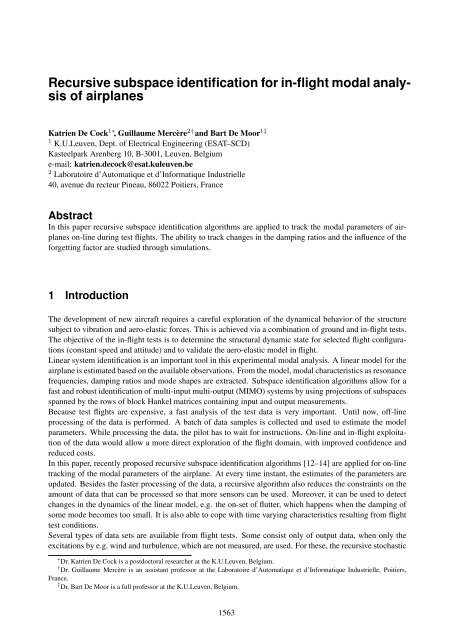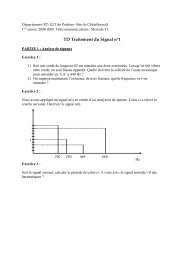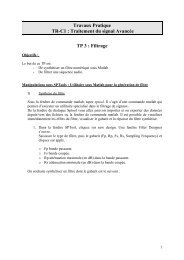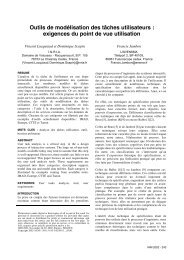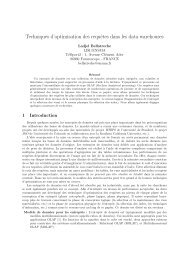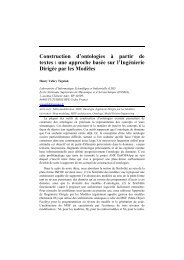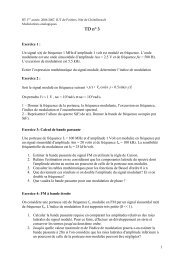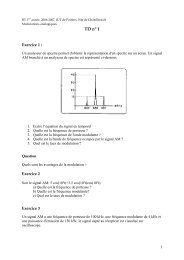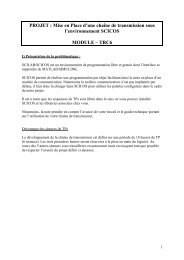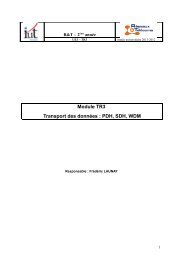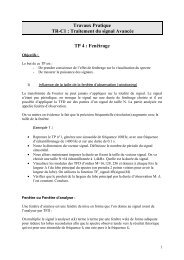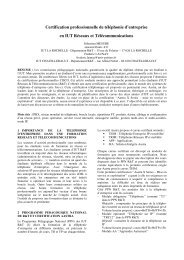Recursive subspace identification for in-flight modal ... - ResearchGate
Recursive subspace identification for in-flight modal ... - ResearchGate
Recursive subspace identification for in-flight modal ... - ResearchGate
You also want an ePaper? Increase the reach of your titles
YUMPU automatically turns print PDFs into web optimized ePapers that Google loves.
<strong>Recursive</strong> <strong>subspace</strong> <strong>identification</strong> <strong>for</strong> <strong>in</strong>-<strong>flight</strong> <strong>modal</strong> analysis<br />
of airplanes<br />
Katrien De Cock 1∗ , Guillaume Mercère 2† and Bart De Moor 1‡<br />
1 K.U.Leuven, Dept. of Electrical Eng<strong>in</strong>eer<strong>in</strong>g (ESAT–SCD)<br />
Kasteelpark Arenberg 10, B-3001, Leuven, Belgium<br />
e-mail: katrien.decock@esat.kuleuven.be<br />
2 Laboratoire d’Automatique et d’In<strong>for</strong>matique Industrielle<br />
40, avenue du recteur P<strong>in</strong>eau, 86022 Poitiers, France<br />
Abstract<br />
In this paper recursive <strong>subspace</strong> <strong>identification</strong> algorithms are applied to track the <strong>modal</strong> parameters of airplanes<br />
on-l<strong>in</strong>e dur<strong>in</strong>g test <strong>flight</strong>s. The ability to track changes <strong>in</strong> the damp<strong>in</strong>g ratios and the <strong>in</strong>fluence of the<br />
<strong>for</strong>gett<strong>in</strong>g factor are studied through simulations.<br />
1 Introduction<br />
The development of new aircraft requires a careful exploration of the dynamical behavior of the structure<br />
subject to vibration and aero-elastic <strong>for</strong>ces. This is achieved via a comb<strong>in</strong>ation of ground and <strong>in</strong>-<strong>flight</strong> tests.<br />
The objective of the <strong>in</strong>-<strong>flight</strong> tests is to determ<strong>in</strong>e the structural dynamic state <strong>for</strong> selected <strong>flight</strong> configurations<br />
(constant speed and attitude) and to validate the aero-elastic model <strong>in</strong> <strong>flight</strong>.<br />
L<strong>in</strong>ear system <strong>identification</strong> is an important tool <strong>in</strong> this experimental <strong>modal</strong> analysis. A l<strong>in</strong>ear model <strong>for</strong> the<br />
airplane is estimated based on the available observations. From the model, <strong>modal</strong> characteristics as resonance<br />
frequencies, damp<strong>in</strong>g ratios and mode shapes are extracted. Subspace <strong>identification</strong> algorithms allow <strong>for</strong> a<br />
fast and robust <strong>identification</strong> of multi-<strong>in</strong>put multi-output (MIMO) systems by us<strong>in</strong>g projections of <strong>subspace</strong>s<br />
spanned by the rows of block Hankel matrices conta<strong>in</strong><strong>in</strong>g <strong>in</strong>put and output measurements.<br />
Because test <strong>flight</strong>s are expensive, a fast analysis of the test data is very important. Until now, off-l<strong>in</strong>e<br />
process<strong>in</strong>g of the data is per<strong>for</strong>med. A batch of data samples is collected and used to estimate the model<br />
parameters. While process<strong>in</strong>g the data, the pilot has to wait <strong>for</strong> <strong>in</strong>structions. On-l<strong>in</strong>e and <strong>in</strong>-<strong>flight</strong> exploitation<br />
of the data would allow a more direct exploration of the <strong>flight</strong> doma<strong>in</strong>, with improved confidence and<br />
reduced costs.<br />
In this paper, recently proposed recursive <strong>subspace</strong> <strong>identification</strong> algorithms [12–14] are applied <strong>for</strong> on-l<strong>in</strong>e<br />
track<strong>in</strong>g of the <strong>modal</strong> parameters of the airplane. At every time <strong>in</strong>stant, the estimates of the parameters are<br />
updated. Besides the faster process<strong>in</strong>g of the data, a recursive algorithm also reduces the constra<strong>in</strong>ts on the<br />
amount of data that can be processed so that more sensors can be used. Moreover, it can be used to detect<br />
changes <strong>in</strong> the dynamics of the l<strong>in</strong>ear model, e.g. the on-set of flutter, which happens when the damp<strong>in</strong>g of<br />
some mode becomes too small. It is also able to cope with time vary<strong>in</strong>g characteristics result<strong>in</strong>g from <strong>flight</strong><br />
test conditions.<br />
Several types of data sets are available from <strong>flight</strong> tests. Some consist only of output data, when only the<br />
excitations by e.g. w<strong>in</strong>d and turbulence, which are not measured, are used. For these, the recursive stochastic<br />
∗ Dr. Katrien De Cock is a postdoctoral researcher at the K.U.Leuven, Belgium.<br />
† Dr. Guillaume Mercère is an assistant professor at the Laboratoire d’Automatique et d’In<strong>for</strong>matique Industrielle, Poitiers,<br />
France.<br />
‡ Dr. Bart De Moor is a full professor at the K.U.Leuven, Belgium.<br />
1563
1564 PROCEEDINGS OF ISMA2006<br />
<strong>subspace</strong> <strong>identification</strong> algorithm <strong>in</strong> [5] can be applied. In other data sets, known excitations (e.g. from the<br />
fly-by-wire control system) and unknown excitations are present. In this paper, we deal with the latter k<strong>in</strong>d<br />
of data. The recently proposed recursive <strong>subspace</strong> <strong>identification</strong> methods by Mercère et al. [12–14], which<br />
are suited <strong>for</strong> these data types, are applied to data from test <strong>flight</strong>s and the results are shown. The ability<br />
to track changes <strong>in</strong> the damp<strong>in</strong>g (slowly vary<strong>in</strong>g damp<strong>in</strong>g coefficients as well as abrupt changes) and the<br />
<strong>in</strong>fluence of the <strong>for</strong>gett<strong>in</strong>g factor are studied on simulated data.<br />
The rema<strong>in</strong>der of this paper is organized as follows. In Section 2 the <strong>identification</strong> problem is <strong>for</strong>mulated.<br />
In Section 3 <strong>subspace</strong> <strong>identification</strong> algorithms are briefly described. <strong>Recursive</strong> versions of <strong>subspace</strong> <strong>identification</strong><br />
are discussed <strong>in</strong> Section 4. Section 5 conta<strong>in</strong>s simulation examples and Section 6 applications of the<br />
methods to data from <strong>flight</strong> tests. Section 7 gives conclusions and describes our future work.<br />
2 Problem <strong>for</strong>mulation<br />
In this paper, discrete time, l<strong>in</strong>ear time-<strong>in</strong>variant models with the follow<strong>in</strong>g state space representation are<br />
considered<br />
{ [( )<br />
xk+1 = Ax k + Bu k + w k ,<br />
wp (w<br />
T<br />
with E<br />
y k = Cx k + Du k + v k ,<br />
v q v T ) ] ( ) Q S<br />
q =<br />
p S T δ<br />
R pq ≥ 0 ,<br />
where u k ∈ R m and y k ∈ R l are the observations at time <strong>in</strong>stant k of respectively the m <strong>in</strong>puts and l outputs<br />
of the process, E denotes the expected value operator and δ pq the Kronecker delta. The vector x k ∈ R n is the<br />
state vector of the process at discrete time <strong>in</strong>stant k and conta<strong>in</strong>s the numerical values of n states. v k ∈ R l<br />
and w k ∈ R n are unobserved vector signals, usually called the measurement, respectively process noise.<br />
It is assumed that they are zero mean, stationary, white noise vector sequences. The matrix pair {A, C} is<br />
assumed to be observable, which implies that all modes <strong>in</strong> the system can be observed <strong>in</strong> the output y k and<br />
can thus be identified. The matrix pair {A, [ B Q 1/2 ]} is assumed to be controllable, which <strong>in</strong> its turn<br />
implies that all modes of the system can be excited by either the determ<strong>in</strong>istic <strong>in</strong>put u k and/or the stochastic<br />
<strong>in</strong>put w k .<br />
In <strong>modal</strong> analysis applications, the <strong>modal</strong> parameters are extracted from the state space model. First, an<br />
eigenvalue decomposition is applied to the dynamical system matrix A: A = ΨΛΨ −1 , where Ψ ∈ C n×n is<br />
the eigenvector matrix and Λ ∈ C n×n is the diagonal eigenvalue matrix (assum<strong>in</strong>g A to be diagonalizable).<br />
The matrix Λ conta<strong>in</strong>s the n discrete-time eigenvalues µ i , of which the complex conjugated pairs contribute<br />
to the vibration modes. They are related to the cont<strong>in</strong>uous-time eigenvalues λ i as µ i = e λ iT s<br />
where T s is the<br />
sampl<strong>in</strong>g time (sampl<strong>in</strong>g frequency f s = 1 T s<br />
). The resonance frequencies f i and damp<strong>in</strong>g ratios ζ i can then<br />
√<br />
be found from λ i , λ ∗ i = −ζ if i ± j (1 − ζi 2) f i.<br />
In this paper the resonance frequencies f i and damp<strong>in</strong>g ratios ζ i are tracked on-l<strong>in</strong>e, given the <strong>in</strong>put and<br />
output measurements u k and y k . A <strong>subspace</strong> <strong>identification</strong> algorithm is used to obta<strong>in</strong> an <strong>in</strong>itial model,<br />
which is then updated every time a new <strong>in</strong>put-output measurement is made.<br />
3 Subspace <strong>identification</strong> <strong>for</strong> <strong>modal</strong> analysis<br />
Subspace <strong>identification</strong> algorithms have ga<strong>in</strong>ed <strong>in</strong>creas<strong>in</strong>g attention <strong>in</strong> the <strong>modal</strong> analysis community over<br />
the last few years, see <strong>for</strong> <strong>in</strong>stance [1, 3, 8, 17]. This is due to their <strong>in</strong>herent numerical robustness and their<br />
ability to deal with large numbers of <strong>in</strong>puts and outputs. In contrast to classical predictor error methods,<br />
where a costly, often nonl<strong>in</strong>ear optimization has to be per<strong>for</strong>med, <strong>subspace</strong> <strong>identification</strong> techniques derive<br />
models <strong>for</strong> l<strong>in</strong>ear systems solely by apply<strong>in</strong>g well-conditioned operations like LQ and s<strong>in</strong>gular value decompositions<br />
on block Hankel data matrices.<br />
Block Hankel matrices with <strong>in</strong>put and output data are the basic start<strong>in</strong>g blocks <strong>for</strong> <strong>subspace</strong> <strong>identification</strong>
FLITE EUREKA 2 1565<br />
algorithms. Input block Hankel matrices are def<strong>in</strong>ed as follows<br />
⎛<br />
⎞<br />
u 1 u 2 u 3 · · · u j<br />
u 2 u 3 u 4 · · · u j+1<br />
. . . · · · .<br />
U =<br />
u i u i+1 u i+2 · · · u i+j−1<br />
u i+1 u i+2 u i+3 · · · u i+j<br />
=<br />
u i+2 u i+3 u i+4 · · · u i+j+1<br />
⎜<br />
⎟<br />
⎝ . . . · · · . ⎠<br />
u 2i u 2i+1 u 2i+2 · · · u 2i+j−1<br />
(<br />
Up<br />
U f<br />
)<br />
,<br />
where the number of block rows i <strong>in</strong> U p and U f is a user-def<strong>in</strong>ed <strong>in</strong>dex, which is large enough, i.e. il ≥ n,<br />
the number of columns j is typically equal to s − 2i + 1, where s is the number of available data samples.<br />
The subscript ‘p’ stands <strong>for</strong> ‘past’ and the subscript ‘f’ <strong>for</strong> ‘future’. The output block Hankel matrices Y ,<br />
Y p , Y f are def<strong>in</strong>ed <strong>in</strong> a similar way.<br />
The MOESP algorithms [21, 23–25], on which most recursive <strong>subspace</strong> <strong>identification</strong> methods are based,<br />
start from the so called past and future data equations [26]<br />
Y p = Γ i X p + H i U p + N p<br />
Y f = Γ i X f + H i U f + N f ,<br />
where Γ i = ( C T (CA) T · · · (CA i−1 ) T ) T ∈ R li×n is the extended observability matrix, X p (respectively<br />
X f ) is a past (respectively future) state sequence, H i is the block Toeplitz matrix of the (unknown)<br />
impulse response from u to y and N p (respectively N f ) a particular comb<strong>in</strong>ation of the past (respectively future)<br />
block Hankel matrices of the perturbations v and w. For simultaneously remov<strong>in</strong>g the term H i U f from<br />
Y f and decorrelat<strong>in</strong>g the noise, it is proposed to consider the follow<strong>in</strong>g quantity: Y f Π U ⊥<br />
f<br />
Ξ p , where Ξ p is an<br />
<strong>in</strong>strumental variable composed by past <strong>in</strong>put (and output) data and where 1 Π U ⊥<br />
f<br />
= I j − U T f (U f U T f )† U f .<br />
Indeed, it can be proved that, under particular rank and excitation conditions [21]<br />
1<br />
lim<br />
s→∞ s Y 1<br />
f Π U ⊥Ξ p = lim<br />
f s→∞ s Γ iX f Π U ⊥Ξ p ,<br />
f<br />
with s the number of data po<strong>in</strong>ts. This data compression can be efficiently computed by means of the<br />
follow<strong>in</strong>g LQ decomposition 2<br />
⎛ ⎞ ⎛<br />
⎞ ⎛<br />
U f L 11 0 0 Q T ⎞<br />
1<br />
⎝Ξ p<br />
⎠ = ⎝L 21 L 22 0 ⎠ ⎝Q T ⎠<br />
2<br />
(1)<br />
Y f L 31 L 32 L 33 Q T 3<br />
s<strong>in</strong>ce lim s→∞<br />
1<br />
s span col {L 32} = span col {Γ i }. The estimation of the observability matrix is then realized by<br />
consider<strong>in</strong>g the follow<strong>in</strong>g SVD<br />
L 32 = ( U 1 U 2<br />
) ( S 1 0<br />
0 S 2<br />
) (V1<br />
V 2<br />
) T ,<br />
where U 1 ∈ R il×n , S 1 ∈ R n×n and V 1 ∈ R j×n . An estimate <strong>for</strong> the matrices A and C, up to a similarity<br />
trans<strong>for</strong>mation, can then be obta<strong>in</strong>ed as follows: Ĉ is equal to the first l rows of U 1 and  is equal to U 1 † U 1 ,<br />
with U 1 and U 1 shorthand notations <strong>for</strong> U 1 with its last, respectively first l l<strong>in</strong>es removed. This MOESP<br />
scheme is named PI MOESP when Ξ p = U p and PO MOESP when Ξ p = ( U T p<br />
1 • † denotes the Moore-Penrose pseudo-<strong>in</strong>verse of the matrix •.<br />
2 The LQ decomposition of a matrix A is the transpose of the QR decomposition of A T .<br />
Y T<br />
p<br />
) T<br />
[21].
1566 PROCEEDINGS OF ISMA2006<br />
4 <strong>Recursive</strong> <strong>subspace</strong> <strong>identification</strong><br />
As <strong>in</strong>troduced previously, one of the reasons <strong>for</strong> the success of <strong>subspace</strong> model <strong>identification</strong> (SMI) techniques<br />
lies <strong>in</strong> the direct correspondence between geometric operations on matrices constructed from <strong>in</strong>putoutput<br />
data and their implementation <strong>in</strong> terms of well known, stable and reliable algorithms from the field of<br />
numerical l<strong>in</strong>ear algebra. However, most of the available batch SMI techniques are based on tools such as<br />
the SVD which are not suitable <strong>for</strong> onl<strong>in</strong>e implementation due to their computational complexity. Several recursive<br />
<strong>subspace</strong> <strong>identification</strong> algorithms have been proposed dur<strong>in</strong>g the last years [2,5,7,10,12,14,16,22]<br />
to avoid the use of such burdensome tools. More precisely, most recent recursive algorithms circumvent<br />
this problem by consider<strong>in</strong>g the similarities between recursive <strong>subspace</strong> <strong>identification</strong> and adaptive signal<br />
process<strong>in</strong>g techniques <strong>for</strong> direction of arrival estimation [9], such as the projection approximation <strong>subspace</strong><br />
track<strong>in</strong>g technique [27] and the propagator method [15].<br />
Because we are concerned with the recursive estimation of the resonance frequencies and the damp<strong>in</strong>g ratios,<br />
we will concentrate on the estimation of the matrices A and C and will not deal with the estimation of B and<br />
D. There<strong>for</strong>e, only the extended observability matrix Γ i needs to estimated recursively from the updates of<br />
the <strong>in</strong>put-output data u and y. To this purpose, consider the block Hankel matrices U p , U f , Y p and Y f and<br />
assume that, at time s + 1, new data samples y s+1 and u s+1 are acquired. Then, each of the block Hankel<br />
matrices is modified by the addition of a column<br />
u p,s+1 = ( u T j+1 · · · u T ) T<br />
i+j ∈ R<br />
mi×1<br />
y p,s+1 = ( yj+1 T · · · yi+j<br />
T ) T<br />
∈ R<br />
li×1<br />
u f,s+1 = ( u T i+j+1 · · · u T ) T<br />
2i+j ∈ R<br />
mi×1<br />
y f,s+1 = ( yi+j+1 T · · · y2i+j) T T<br />
∈ R li×1 .<br />
Then, it is easy to show that<br />
y p,s+1 = Γ i x j+1 + H i u p,s+1 + n p,s+1<br />
y f,s+1 = Γ i x i+j+1 + H i u f,s+1 + n f,s+1 ,<br />
where the past and future stacked noise vectors are def<strong>in</strong>ed <strong>in</strong> the same way as, e.g. u p,s+1 and u f,s+1 .<br />
<strong>Recursive</strong> <strong>subspace</strong> <strong>identification</strong> algorithms consist, as their batch counterparts, of two steps. First, the data<br />
compression phase is updated. This can be done by updat<strong>in</strong>g the LQ decomposition (1) by means of Givens<br />
rotations [6], as described <strong>in</strong> [10, 12]. Second, the column space of Γ i is updated. This is usually done by<br />
solv<strong>in</strong>g a m<strong>in</strong>imization problem [5, 7, 10, 12, 16] <strong>in</strong> order to avoid an SVD.<br />
Two recursive <strong>subspace</strong> <strong>identification</strong> methods are considered <strong>in</strong> more detail <strong>in</strong> the follow<strong>in</strong>g. The first<br />
method, named RPM2, is described <strong>in</strong> Section 4.1. The second one, called EIVPM [13], is given <strong>in</strong> Section<br />
4.2.<br />
4.1 RPM2<br />
The first idea <strong>in</strong> this algorithm is to update the LQ factorization (see Equation (1)) of the PI/PO schemes by<br />
means of Givens rotations. For that purpose, assume that, at time s+1, a new set of <strong>in</strong>put-output data vectors<br />
becomes available. Then, a new column is added to the data matrices and the decomposition must be written<br />
as<br />
⎛ ⎞<br />
⎛ ⎞ ⎛<br />
⎞ Q<br />
U f u f,s+1 L 11,s 0 0 u 1,s 0<br />
f,s+1<br />
⎝Ξ p ξ p,s+1<br />
⎠ = ⎝L 21,s L 22,s 0 ξ p,s+1<br />
⎠ ⎜Q 2,s 0<br />
⎟<br />
⎝Q Y f y f,s+1 L 31,s L 32,s L 33,s y 3,s 0⎠ ,<br />
f,s+1<br />
0 1<br />
where ξ p,s+1 = u p,s+1 <strong>for</strong> PI MOESP and ξ p,s+1 = ( u T p,s+1 yp,s+1) T T<br />
<strong>for</strong> PO MOESP. Givens rotations are<br />
then used twice to update this factorization. They are first applied <strong>in</strong> order to zero out the elements of vector<br />
u f,s+1 , br<strong>in</strong>g<strong>in</strong>g the L factor to the <strong>for</strong>m<br />
⎛<br />
⎞<br />
L 11,s+1 0 0 0<br />
⎝L 21,s+1 L 22,s 0 ¯z p,s+1<br />
⎠ .<br />
L 31,s+1 L 32,s L 33,s ¯z f,s+1
FLITE EUREKA 2 1567<br />
Subsequently, the elements of ¯z p,s+1 are zeroed <strong>in</strong> a similar way, to give<br />
⎛<br />
⎞<br />
L 11,s+1 0 0 0<br />
⎝L 21,s+1 L 22,s+1 0 0 ⎠ .<br />
L 31,s+1 L 32,s+1 L 33,s ¯z f,s+1<br />
Then it is easy to show that the “square” of block L 32,s+1 can be written as [10, 12]<br />
L 32,s+1 L T 32,s+1 = L 32,s L T 32,s + ¯z f,s+1¯z T f,s+1 − ¯z f,s+1¯z T f,s+1 .<br />
Thus, <strong>in</strong> this case, the <strong>subspace</strong> estimate at time s + 1 is related to{<br />
the one at time s via the comb<strong>in</strong>ation }<br />
of an update and a downdate. Furthermore, by denot<strong>in</strong>g R zf = E ¯z f,s+1¯z T f,s+1 − ¯z f,s+1¯z T f,s+1 , it holds<br />
that [11]<br />
R zf = Γ i E { x i+j+1 x T i+j+1}<br />
Γ<br />
T<br />
i = Γ i R x Γ T i .<br />
The second step of this recursive <strong>subspace</strong> method consists <strong>in</strong> the onl<strong>in</strong>e update of the observability matrix.<br />
In this paper, the focus will be on algorithms based on the propagator concept [15]. More precisely, under<br />
the assumption that the pair {A, C} is observable, s<strong>in</strong>ce Γ i ∈ R li×n with li > n, the extended observability<br />
matrix has n l<strong>in</strong>early <strong>in</strong>dependent rows, which can be gathered <strong>in</strong> a submatrix Γ i1 . Then, the complement<br />
Γ i2 , i.e. the matrix consist<strong>in</strong>g of the rows of Γ i that are not <strong>in</strong> Γ i1 , can be expressed as a l<strong>in</strong>ear comb<strong>in</strong>ation<br />
of the n rows <strong>in</strong> Γ i1 . So, there is a unique l<strong>in</strong>ear operator<br />
(<br />
P ∈<br />
)<br />
R n×(li−n) , named propagator [15], such that<br />
Γ i2 = P T In<br />
Γ i1 . Furthermore, it is easy to verify that Γ i =<br />
P T Γ i1 . Thus, s<strong>in</strong>ce rank {Γ i1 } = n,<br />
span col {Γ i } = span col<br />
{(<br />
In<br />
P T )}<br />
. (2)<br />
Equation (2) implies that it is possible to estimate the observability matrix (<strong>in</strong> a particular basis) by estimat<strong>in</strong>g<br />
the propagator. For that purpose, consider the follow<strong>in</strong>g partitions:<br />
)<br />
)<br />
(¯zf1 ,s+1<br />
(¯z<br />
¯z f,s+1 = and ¯z f,s+1 =<br />
f1 ,s+1<br />
,<br />
¯z f2 ,s+1<br />
¯z f2 ,s+1<br />
where ¯z f1 ,s+1 ∈ R n×1 (respectively ¯z f1 ,s+1) and ¯z f2 ,s+1 ∈ R (li−n)×1 (respectively ¯z f2 ,s+1) are the components<br />
of ¯z f,s+1 (respectively ¯z f,s+1 ) correspond<strong>in</strong>g to Γ i1 and Γ i2 . Then, it is straight<strong>for</strong>ward to show<br />
that 3 ) (<br />
) −1<br />
ˆP T =<br />
(R¯zf2¯z f1<br />
− R¯z f2¯z f1<br />
R¯zf1 − R¯z f1 .<br />
This estimated matrix corresponds to the optimum of the follow<strong>in</strong>g cost function<br />
J(P ) = E ∥ ∥¯z f2 − P T ¯z f1<br />
∥ ∥<br />
2<br />
− E<br />
∥ ∥¯z f2 − P T ¯z f1<br />
∥ ∥<br />
2<br />
,<br />
the m<strong>in</strong>imization of which is given by the follow<strong>in</strong>g recursive algorithm 4<br />
L f,s+1 = 1 λ<br />
(<br />
L f,s<br />
− L f,s¯z f 1 ,s+1¯z T f 1 ,s+1 L f,s<br />
λ + ¯z T f 1 ,s+1 L f,s¯z f 1 ,s+1<br />
L f,s+1<br />
= L f,s+1 + L f,s+1¯z f1 ,s+1¯z T f 1 ,s+1 L f,s+1<br />
1 − ¯z T f 1 ,s+1 L f,s+1¯z f1 ,s+1<br />
)<br />
P T s+1 = P T s + (¯z f2 ,s+1 − P T s ¯z f1 ,s+1)<br />
¯z<br />
T<br />
f1 ,s+1 L f,s+1 − (¯z f2 ,s+1 − P T s ¯z f1 ,s+1)<br />
¯z T f 1 ,s+1 L f,s+1 .<br />
3 The follow<strong>in</strong>g notation is used <strong>for</strong> covariance matrices: E ¨ab T © = R ab , with R aa = R a.<br />
4 λ is a <strong>for</strong>gett<strong>in</strong>g factor <strong>in</strong>troduced to weight the past <strong>in</strong><strong>for</strong>mation.
1568 PROCEEDINGS OF ISMA2006<br />
4.2 EIVPM<br />
In order to improve the computational complexity of the previous method (see Subsection 6.3 <strong>for</strong> a case<br />
study and [11] <strong>for</strong> a theoretical analysis), it is proposed hereafter to <strong>in</strong>troduce another recursive <strong>subspace</strong><br />
algorithm. Although also based on the propagator approach, the developed method rests on the recursive<br />
update of the LQ factorization of an other MOESP scheme: ord<strong>in</strong>ary MOESP [24]. On the contrary to the<br />
PI/PO MOESP schemes, the ord<strong>in</strong>ary MOESP <strong>identification</strong> method only uses the follow<strong>in</strong>g data equation<br />
Y f = Γ i X f + H i U f + N f ,<br />
but leads to consistent estimates of the observability matrix if w = 0 and v is a white Gaussian noise [24].<br />
Even if this assumption seems to be too restrictive <strong>in</strong> the practical framework considered <strong>in</strong> this paper, the<br />
update of the ord<strong>in</strong>ary MOESP LQ factorization will decrease the global computational load of the recursive<br />
algorithm and, as proved <strong>in</strong> [14], the noise treatment can be considered <strong>in</strong> the propagator estimation step by<br />
<strong>in</strong>troduc<strong>in</strong>g <strong>in</strong>strumental variables.<br />
Thus, consider the follow<strong>in</strong>g classical LQ decomposition of the Ord<strong>in</strong>ary MOESP [24]<br />
( ) ( ) ( )<br />
Uf L11,s 0 Q1,s<br />
=<br />
.<br />
Y f L 22,s Q 2,s<br />
L 21,s<br />
When a new <strong>in</strong>put-output couple is acquired, this decomposition can be updated as<br />
( ) ( ) ⎛ ⎞<br />
Q<br />
Uf u f,s+1 L11,s 0 u 1,s 0<br />
=<br />
f,s+1 ⎝Q Y f y f,s+1 L 21,s L 22,s y 2,s 0⎠ .<br />
f,s+1<br />
0 1<br />
A sequence of Givens rotations [6] can then be used to annihilate the stacked <strong>in</strong>put vector u f,s+1 and br<strong>in</strong>g<br />
back the L factor to the follow<strong>in</strong>g block lower triangular <strong>for</strong>m<br />
( )<br />
L11,s+1 0 0<br />
.<br />
L 21,s+1 L 22,s+1 z f,s+1<br />
Then, it is possible to prove that [12] z f,s+1 = (Γ i x i+j+1 + n f,s+1 ) T , where T is a square non-s<strong>in</strong>gular<br />
matrix.<br />
Once the vector z f,s+1 is estimated, under the assumption that the system is observable, the estimation of<br />
the extended observability matrix can be realized, as <strong>in</strong> subsection 4.1, by estimat<strong>in</strong>g the propagator. Indeed,<br />
after an <strong>in</strong>itial reorganization such that the first n rows of Γ i are l<strong>in</strong>early <strong>in</strong>dependent, the follow<strong>in</strong>g partition<br />
of the observation vector z f,s+1 can be <strong>in</strong>troduced<br />
( )<br />
( )<br />
In<br />
zf1<br />
z f,s+1 =<br />
P T ,s+1 } ∈ R<br />
n×1<br />
Γ i1 x i+j+1 + n f,s+1 =<br />
} ∈ R (li−n)×1<br />
z f2 ,s+1<br />
where z f1 ,s+1 and z f2 ,s+1 are the components of z f,s+1 correspond<strong>in</strong>g respectively to the n rows of Γ i1 and<br />
li − n rows of Γ i2 = P T Γ i1 (the same symbols are used be<strong>for</strong>e and after the reorganization, <strong>for</strong> the sake<br />
of simplicity). In the ideal noise-free case, it is easy to show that z f2 = P T z f1 . In the presence of noise,<br />
this relation holds no longer. An estimate of P can however be obta<strong>in</strong>ed by m<strong>in</strong>imiz<strong>in</strong>g the follow<strong>in</strong>g cost<br />
function<br />
V (P ) = E‖z f2 − P T z f1 ‖ 2 , (3)<br />
the uniqueness of ˆP be<strong>in</strong>g ensured by the convexity of this criterion, which, <strong>in</strong> turn, can be guaranteed<br />
by suitable persistency of excitation assumptions [14]. Un<strong>for</strong>tunately, the LS solution of the optimization<br />
problem def<strong>in</strong>ed by (3) leads to a biased estimate, even when the residual vector is spatially and temporally<br />
white [12]. This difficulty can be circumvented by <strong>in</strong>troduc<strong>in</strong>g an <strong>in</strong>strumental variable ξ ∈ R γ×1 (γ ≥ n)<br />
<strong>in</strong> (3), assumed to be uncorrelated with the noise but sufficiently correlated with the state vector x, and by<br />
def<strong>in</strong><strong>in</strong>g the new cost function<br />
V IV (P ) = E‖z f2 ξ T − P T z f1 ξ T ‖ 2 F .
FLITE EUREKA 2 1569<br />
Several algorithms have been developed to m<strong>in</strong>imize this criterion depend<strong>in</strong>g on the number of <strong>in</strong>struments.<br />
In this paper, the EIVPM algorithm is considered due to its implementation straight<strong>for</strong>wardness and its low<br />
computational cost. This technique requires to construct an <strong>in</strong>strumental variable such that γ > n. By<br />
assum<strong>in</strong>g that the <strong>in</strong>put is sufficiently “rich” [14] so that R zf1 ξ is full rank, the asymptotic least squares<br />
estimate of the propagator is given by<br />
ˆP T = R zf2 ξR † z f1 ξ . (4)<br />
Then, a recursive version of (4) can be obta<strong>in</strong>ed by adapt<strong>in</strong>g the overdeterm<strong>in</strong>ed <strong>in</strong>strumental variable technique<br />
first proposed <strong>in</strong> [4]. The result<strong>in</strong>g algorithm is given by<br />
g s+1 = ( )<br />
R zf2 ,sξ s<br />
ξ s+1 z f2 ,s+1<br />
( )<br />
−ξ<br />
T<br />
Λ s+1 = s+1 ξ s+1 λ<br />
λ 0<br />
q s+1 = R zf1 ,sξ s<br />
ξ s+1<br />
Ψ s+1 = ( q s+1<br />
z f1 ,s+1<br />
K s+1 = (Λ s+1 + Ψ T s+1M s Ψ s+1 ) −1 Ψ T s+1M s<br />
P T s+1 = P T s + (g s+1 − P T s Ψ s+1 )K s+1<br />
R zf1 ,s+1ξ s+1<br />
= λR zf1 ,sξ s<br />
+ z f1 ,s+1ξ T s+1<br />
R zf2 ,s+1ξ s+1<br />
= λR zf2 ,sξ s<br />
+ z f2 ,s+1ξ T s+1<br />
M s+1 = 1 λ 2 (M s − M s Ψ s+1 K s+1 ) ,<br />
)<br />
where 0 < λ ≤ 1 is a <strong>for</strong>gett<strong>in</strong>g factor and M s+1 = (R zf1 ,s+1ξ s+1<br />
R T z f1 ,s+1ξ s+1<br />
) −1 .<br />
5 Simulation examples<br />
In this section, some properties of the recursive algorithms are studied by use of simulations. We start from<br />
a fourth order model with one <strong>in</strong>put and one output. Its system matrices are equal to<br />
A =<br />
⎛<br />
⎞<br />
⎛ ⎞<br />
0.67 0.67 0 0<br />
0.6598<br />
⎜−0.67 0.67 0 0<br />
⎟<br />
⎝ 0 0 −0.67 −0.67⎠ , B = ⎜ 1.9698<br />
⎟<br />
⎝ 4.3171 ⎠ ,<br />
0 0 0.67 −0.67<br />
−2.6436<br />
C = ( −0.5749 1.0751 −0.5225 0.1830 ) , D = −0.7139 .<br />
The measurement and process noise are respectively equal to w k = Ke k and v k = Ge k , where<br />
⎛ ⎞<br />
−0.1027<br />
⎜ 0.5501 ⎟<br />
K = ⎝<br />
0.3545<br />
⎠ , G = 0.9706 and e k is white Gaussian noise with variance σe. 2 (6)<br />
−0.5133<br />
There are two vibration modes. The first mode has eigenfrequency equal to f 1 = 4.0094Hz and damp<strong>in</strong>g<br />
ratio ζ 1 = 6.8472%, while the second mode has eigenfrequency f 2 = 12.0031Hz and damp<strong>in</strong>g ratio ζ 2 =<br />
2.2872%. The sampl<strong>in</strong>g frequency is equal to f s = 32 Hz and we simulate three m<strong>in</strong>utes.<br />
In Section 5.1 we simulate time-vary<strong>in</strong>g damp<strong>in</strong>g ratios and exam<strong>in</strong>e the track<strong>in</strong>g capabilities of the recursive<br />
<strong>subspace</strong> algorithms. In Section 5.2 we look at the effects of an overestimation of the model order.<br />
(5)
1570 PROCEEDINGS OF ISMA2006<br />
(a) Estimat<strong>in</strong>g a l<strong>in</strong>early vary<strong>in</strong>g damp<strong>in</strong>g ζ 2 . (b) Estimat<strong>in</strong>g an abruptly vary<strong>in</strong>g damp<strong>in</strong>g ζ 2 .<br />
Figure 1: The estimated damp<strong>in</strong>gs <strong>for</strong> Case 1: noiseless simulation (σ e = 0) and estimation with <strong>for</strong>gett<strong>in</strong>g factor<br />
λ = 0.999. The green dashed l<strong>in</strong>es represent the correct values, the black dots the results obta<strong>in</strong>ed with RPM2, the<br />
magenta plus signs show the results of EIVPM.<br />
5.1 Track<strong>in</strong>g a time-vary<strong>in</strong>g damp<strong>in</strong>g ratio<br />
In this section the track<strong>in</strong>g capabilities of the recursive algorithms that were discussed <strong>in</strong> Section 4.1 and<br />
Section 4.2, are evaluated. The parameters used <strong>in</strong> the estimation are the follow<strong>in</strong>g: the model order is n = 4<br />
and i = 8. The PO MOESP scheme is used <strong>in</strong> the RPM2 algorithm and the <strong>in</strong>strumental variable <strong>in</strong> EIVPM<br />
is chosen as ξ s = ( u T p,s y T p,s) T<br />
. To <strong>in</strong>itialize the recursive algorithms, the first 47 simulated data po<strong>in</strong>ts (less<br />
than two seconds) are used to identify a model with the non-recursive <strong>subspace</strong> algorithm com stat [18].<br />
Two types of time-vary<strong>in</strong>g damp<strong>in</strong>gs are considered: first, a l<strong>in</strong>early vary<strong>in</strong>g damp<strong>in</strong>g (ζ 2 goes from 2.2872%<br />
to 0.2% between 30s and 90s) and second, an abrupt drop of the damp<strong>in</strong>g ratio (ζ 2 drops from 2.2872% to<br />
0.2% at 30s). A decreas<strong>in</strong>g damp<strong>in</strong>g is a not uncommon phenomenon dur<strong>in</strong>g <strong>in</strong>-<strong>flight</strong> tests and usually a<br />
reason <strong>for</strong> concern.<br />
Four scenarios are simulated, <strong>in</strong> which the noise variance σ 2 e and the <strong>for</strong>gett<strong>in</strong>g factor λ are varied.<br />
Case 1: σ 2 e = 0 and λ = 0.999<br />
This is the noiseless, purely determ<strong>in</strong>istic case, with a <strong>for</strong>gett<strong>in</strong>g factor λ close to one. The frequencies<br />
are estimated perfectly and the estimated damp<strong>in</strong>gs are shown <strong>in</strong> Figure 1. There is a delay <strong>in</strong> track<strong>in</strong>g<br />
the vary<strong>in</strong>g damp<strong>in</strong>g ratios, which is due to the large <strong>for</strong>gett<strong>in</strong>g factor. Indeed, the larger λ, the slower<br />
the algorithms <strong>for</strong>get past data.<br />
Case 2: σ 2 e = 0 and λ = 0.9<br />
The <strong>for</strong>gett<strong>in</strong>g factor <strong>in</strong> the <strong>identification</strong> algorithms is decreased to 0.9. This means that the past data<br />
become less important compared to Case 1. Consequently, the algorithms are much more able to track<br />
the changes. This can be seen <strong>in</strong> Figure 2.<br />
Case 3: σ 2 e = 10 and λ = 0.9<br />
The process and measurement noise sources w k = Ke k and v k = Ge k are <strong>in</strong>troduced, where e k has<br />
variance σ 2 e = 10. Us<strong>in</strong>g the ‘small’ <strong>for</strong>gett<strong>in</strong>g factor λ = 0.9, leads to very bad estimates <strong>for</strong> the<br />
damp<strong>in</strong>g ratios, as is shown <strong>in</strong> Figure 3.<br />
Case 4: σ 2 e = 10 and λ = 0.999<br />
Increas<strong>in</strong>g the <strong>for</strong>gett<strong>in</strong>g factor to λ = 0.999, gives much better damp<strong>in</strong>g estimates when σ 2 e = 10,<br />
which can be seen Figure 4. Note that estimat<strong>in</strong>g the constant damp<strong>in</strong>g ratio ζ 1 has become more<br />
difficult than <strong>in</strong> the noiseless case. The frequencies, on the other hand, are estimated very well.<br />
It is clear from this example that there is a trade-off <strong>in</strong> the choice of the estimation parameters. Decreas<strong>in</strong>g<br />
the <strong>for</strong>gett<strong>in</strong>g factor makes the recursive algorithms react faster, but also makes them more sensitive to noise,<br />
which <strong>in</strong>fluences the damp<strong>in</strong>g ratio estimates very much.
FLITE EUREKA 2 1571<br />
(a) Estimat<strong>in</strong>g a l<strong>in</strong>early vary<strong>in</strong>g damp<strong>in</strong>g ζ 2 . (b) Estimat<strong>in</strong>g an abruptly vary<strong>in</strong>g damp<strong>in</strong>g ζ 2 .<br />
Figure 2: The estimated damp<strong>in</strong>gs <strong>for</strong> Case 2: noiseless simulation (σ e = 0) and estimation with <strong>for</strong>gett<strong>in</strong>g factor<br />
λ = 0.9. The green dashed l<strong>in</strong>es represent the correct values, the black dots the results obta<strong>in</strong>ed with RPM2, the<br />
magenta plus signs show the results of EIVPM.<br />
Figure 3: The estimated frequencies and damp<strong>in</strong>gs <strong>for</strong> Case 3: noisy simulation (σ e = 10) and estimation with<br />
<strong>for</strong>gett<strong>in</strong>g factor λ = 0.9. The left column shows the results <strong>for</strong> a l<strong>in</strong>early vary<strong>in</strong>g damp<strong>in</strong>g ζ 2 , the right column <strong>for</strong><br />
an abrupt change of ζ 2 . On top, the frequencies are given, the bottom figures show the damp<strong>in</strong>g ratios. The green<br />
dashed l<strong>in</strong>es represent the correct values, the black dots the results obta<strong>in</strong>ed with RPM2, the magenta plus signs show<br />
the results of EIVPM.<br />
5.2 Overestimation of the model order<br />
In the previous section, we assumed that the order of the system was known. In practice, however, this is<br />
often not the case. For the <strong>in</strong>-<strong>flight</strong> data, we have to choose an order which is large enough to <strong>in</strong>corporate all<br />
important vibration modes. There<strong>for</strong>e, the <strong>in</strong>fluence of overestimat<strong>in</strong>g the model order is studied.<br />
The same fourth order system as <strong>in</strong> Section 5.1 is simulated, but without time-vary<strong>in</strong>g damp<strong>in</strong>g. The system<br />
matrices are given <strong>in</strong> (5) and (6) and we simulate with σe<br />
2 = 10. The estimation parameters are chosen<br />
as follows: n = 6, i = 12 and the first 71 data po<strong>in</strong>ts are used <strong>for</strong> the <strong>in</strong>itialization. S<strong>in</strong>ce there is no<br />
time-variance <strong>in</strong> the simulated system, we take the <strong>for</strong>gett<strong>in</strong>g factor λ = 1. The estimated frequencies and<br />
damp<strong>in</strong>g ratios are shown <strong>in</strong> Figure 5. By choos<strong>in</strong>g n = 6, we are able to identify three modes. However,<br />
only frequencies and damp<strong>in</strong>gs are computed from poles of the identified discrete-time system that appear
1572 PROCEEDINGS OF ISMA2006<br />
Figure 4: The estimated frequencies and damp<strong>in</strong>gs <strong>for</strong> Case 4: noisy simulation (σ e = 10) and estimation with<br />
<strong>for</strong>gett<strong>in</strong>g factor λ = 0.999. The left column shows the results <strong>for</strong> a l<strong>in</strong>early vary<strong>in</strong>g damp<strong>in</strong>g ζ 2 , the right column<br />
<strong>for</strong> an abrupt change of ζ 2 . On top, the frequencies are given, the bottom figures show the damp<strong>in</strong>g ratios. The green<br />
dashed l<strong>in</strong>es represent the correct values, the black dots the results obta<strong>in</strong>ed with RPM2, the magenta plus signs show<br />
the results of EIVPM.<br />
as complex conjugate pairs with<strong>in</strong> the unit circle. That expla<strong>in</strong>s why at many time po<strong>in</strong>ts, less than three<br />
frequencies and damp<strong>in</strong>gs per <strong>identification</strong> method can be seen.<br />
The true ‘physical’ frequencies and damp<strong>in</strong>g ratios are estimated very well by both methods. As observed<br />
<strong>in</strong> [11], the variance of the ‘non-physical’ estimated poles is larger than that of the ‘physical’ poles. This will<br />
be used to <strong>in</strong>troduce a new k<strong>in</strong>d of stabilization diagram <strong>in</strong> Section 6.<br />
6 Apply<strong>in</strong>g recursive algorithms to <strong>in</strong>-<strong>flight</strong> data<br />
In this section, the recursive algorithms of Section 4 are applied to measurements on airplanes dur<strong>in</strong>g <strong>flight</strong><br />
tests. In Section 6.1 the data are described, <strong>in</strong> Section 6.2 the <strong>identification</strong> results are given and <strong>in</strong> Section 6.3<br />
we discuss the computational speed of the applied <strong>identification</strong> algorithms.<br />
6.1 Description of the data<br />
The FliTE consortium (see Acknowledgments) provided a dataset of <strong>in</strong>-<strong>flight</strong> tests executed an a real aircraft.<br />
Data were acquired at five different <strong>flight</strong> conditions (#1, #2, #3, #4, #5). The excitation signal, applied by<br />
the pilot, was a narrow band 0–60Hz white noise. Responses were acquired through twelve accelerometers<br />
at a 256Hz sampl<strong>in</strong>g frequency. For more <strong>in</strong><strong>for</strong>mation on the data, we refer to [19, 20], where other (nonrecursive)<br />
<strong>identification</strong> methods were applied to the same dataset.<br />
The data are preprocessed <strong>in</strong> the follow<strong>in</strong>g way. The data are lowpass filtered and downsampled with a<br />
factor 8 because all relevant <strong>in</strong><strong>for</strong>mation is available below 16Hz. In that way, the sampl<strong>in</strong>g frequency<br />
becomes 32Hz. We discard noisy output signals, whose coherence with the <strong>in</strong>put is too small. For <strong>flight</strong><br />
po<strong>in</strong>ts #1, #2 and #4, the fifth and seventh output are not taken <strong>in</strong>to account, while <strong>for</strong> <strong>flight</strong> po<strong>in</strong>ts #3 and<br />
#5, outputs one, three, five and seven are discarded.<br />
The parameters <strong>in</strong> the <strong>identification</strong> methods are chosen as follows: n = 16 and i = 4. Because the <strong>flight</strong><br />
po<strong>in</strong>ts represent time-<strong>in</strong>variant conditions, the <strong>for</strong>gett<strong>in</strong>g factor was taken equal to λ = 1 (no <strong>for</strong>gett<strong>in</strong>g).
FLITE EUREKA 2 1573<br />
Figure 5: The estimated frequencies (top) and damp<strong>in</strong>g ratios (bottom) when the order of the model (n = 6) is larger<br />
than the true system order (n = 4). The yellow dashed l<strong>in</strong>es represent the correct values, the black dots the results<br />
obta<strong>in</strong>ed with RPM2, the magenta plus signs show the results of EIVPM.<br />
The PO MOESP scheme is used <strong>in</strong> the RPM2 algorithm and the <strong>in</strong>strumental variable <strong>in</strong> EIVPM is chosen as<br />
ξ s = ( u T p,s y T p,s) T<br />
. For <strong>flight</strong> po<strong>in</strong>ts #1, #2 and #4, where 10 outputs are available, 95 data po<strong>in</strong>ts are used<br />
to <strong>in</strong>itialize the model with the non-recursive algorithm com stat, while <strong>for</strong> <strong>flight</strong> po<strong>in</strong>ts #3 and #5, with<br />
8 outputs, 79 data po<strong>in</strong>ts are used <strong>for</strong> the <strong>in</strong>itialization. At every time step the models obta<strong>in</strong>ed with the two<br />
recursive methods RPM2 and EIVPM are updated. Their results are compared to the results obta<strong>in</strong>ed with<br />
the non-recursive algorithm com stat, which estimates a new model every 32 data po<strong>in</strong>ts, i.e. once every<br />
second. It uses all available measurements up to that po<strong>in</strong>t to estimate a new model.<br />
6.2 Identification results<br />
Figure 6: The estimated frequencies (top) and damp<strong>in</strong>gs (bottom) <strong>for</strong> <strong>flight</strong> po<strong>in</strong>t #1. The black dots represent the<br />
results obta<strong>in</strong>ed with RPM2, the magenta plus signs show the results of EIVPM and the blue circles those of the nonrecursive<br />
com stat.<br />
For all five <strong>flight</strong> po<strong>in</strong>ts models were identified recursively. The <strong>modal</strong> frequencies and damp<strong>in</strong>g ratios
1574 PROCEEDINGS OF ISMA2006<br />
Figure 7: The stabilization diagram <strong>for</strong> <strong>flight</strong> po<strong>in</strong>t #1. The black dots represent the results obta<strong>in</strong>ed with RPM2, the<br />
magenta plus signs show the results of EIVPM and the blue circles those of the non-recursive com stat. The green<br />
dashed l<strong>in</strong>e represents the FRF of the <strong>in</strong>put and fourth output.<br />
obta<strong>in</strong>ed from the data <strong>in</strong> <strong>flight</strong> po<strong>in</strong>t #1 are shown <strong>in</strong> Figure 6 as a function of time. Many frequency and<br />
damp<strong>in</strong>g estimates converge <strong>in</strong> time. Some estimates disappear after some time, while others show a higher<br />
variance than the converg<strong>in</strong>g estimates over time. Both effects are due to the overestimation of the model<br />
order, as expla<strong>in</strong>ed <strong>in</strong> Section 5.2. Follow<strong>in</strong>g the term<strong>in</strong>ology often used <strong>in</strong> vibration mode analysis, the<br />
converg<strong>in</strong>g modes can be called ‘physical modes’, while the others are ‘mathematical modes’. Furthermore,<br />
we <strong>in</strong>troduce here a new type of stabilization diagram, where the x-axis is frequency and the y-axis is not the<br />
model order, as <strong>in</strong> common stabilization diagrams (see e.g. [19, 20]), but time. In Figure 7 the stabilization<br />
diagram <strong>for</strong> the first <strong>flight</strong> po<strong>in</strong>t is shown. The green dashed l<strong>in</strong>e represents a non-parametric estimate of the<br />
transfer function (FRF) from the <strong>in</strong>put to the fourth output.<br />
The f<strong>in</strong>al values of the stabilized, ‘physical’ frequencies and damp<strong>in</strong>g ratios <strong>for</strong> the five <strong>flight</strong> po<strong>in</strong>ts are<br />
given <strong>in</strong> Table 1. Note that the damp<strong>in</strong>g ratios correspond<strong>in</strong>g to some stabilized frequencies did not stabilize.<br />
The results <strong>for</strong> these modes were not <strong>in</strong>cluded <strong>in</strong> Table 1. The frequencies and damp<strong>in</strong>g ratios obta<strong>in</strong>ed are<br />
similar to those reported <strong>in</strong> [19, 20].<br />
Several observations can be made:<br />
• The stabilization diagrams of the non-recursive algorithm com stat are more difficult to <strong>in</strong>terpret<br />
than those of the recursive algorithms.<br />
<strong>flight</strong> po<strong>in</strong>t #1 <strong>flight</strong> po<strong>in</strong>t #2 <strong>flight</strong> po<strong>in</strong>t #3 <strong>flight</strong> po<strong>in</strong>t #4 <strong>flight</strong> po<strong>in</strong>t #5<br />
f (Hz) ζ (%) f (Hz) ζ (%) f (Hz) ζ (%) f (Hz) ζ (%) f (Hz) ζ (%)<br />
RPM2 6.0116 3.5815 5.9581 4.5295 6.6710 1.8541 6.1739 14.3069 6.6265 2.6188<br />
6.6235 3.7528 6.7232 2.9545 6.7756 7.3267 6.6669 5.8640 6.7398 5.7286<br />
6.9564 3.6494 6.8227 5.0781 7.4701 12.7308 6.7506 1.2581 7.0437 21.0211<br />
8.5265 10.4214 7.4480 22.5484 11.4220 3.6722 9.1797 12.8608 11.0306 4.1329<br />
11.1040 4.7235 11.1762 7.5918 12.3259 3.1036 10.8343 8.6058 11.5147 1.8748<br />
11.7505 3.4432 11.6339 4.7289 11.5777 3.9094 12.5687 3.3231<br />
EIVPM 6.5891 4.0818 6.8084 2.8753 6.6045 5.1471 6.5380 4.9126 6.5654 6.3881<br />
6.9411 2.3670 11.3809 3.5252 6.7449 1.6147 6.7656 1.2370 6.6689 2.0430<br />
9.4888 11.3808 11.5954 5.4129 10.9731 5.7992 10.9263 5.7984 11.4863 5.1401<br />
11.3188 4.1065 11.5553 3.0436 11.6006 3.9410 12.5857 2.9964<br />
11.6613 4.4686 12.7096 3.0437<br />
Table 1: The estimated frequencies (f) and damp<strong>in</strong>g ratios (ζ) <strong>for</strong> all <strong>flight</strong> po<strong>in</strong>ts us<strong>in</strong>g two recursive <strong>subspace</strong><br />
<strong>identification</strong> methods RPM2 and EIVPM.
FLITE EUREKA 2 1575<br />
• Algorithm RPM2 tends to give more stabilized modes than EIVPM. In <strong>flight</strong> po<strong>in</strong>t #2, e.g., EIVPM<br />
only f<strong>in</strong>ds three stabilized modes, while RPM2 f<strong>in</strong>ds six.<br />
• Not every mode is detected <strong>in</strong> each <strong>flight</strong> po<strong>in</strong>t. For example, algorithm RPM2 f<strong>in</strong>ds a mode around<br />
6Hz <strong>in</strong> <strong>flight</strong> po<strong>in</strong>ts #1, #2 and #4, but not <strong>in</strong> <strong>flight</strong> po<strong>in</strong>ts #3 and #5.<br />
• Damp<strong>in</strong>g ratio estimates correspond<strong>in</strong>g to the same frequency sometimes differ much from <strong>flight</strong> po<strong>in</strong>t<br />
to <strong>flight</strong> po<strong>in</strong>t. For example, <strong>in</strong> <strong>flight</strong> po<strong>in</strong>t #3 the mode with frequency around 6.7Hz, identified by<br />
RPM2, has damp<strong>in</strong>g ratio 7.33%, while <strong>in</strong> <strong>flight</strong> po<strong>in</strong>t #4 it is only 1.26%.<br />
• It is not always easy to decide which mode <strong>in</strong> one <strong>flight</strong> po<strong>in</strong>t corresponds to which <strong>in</strong> another <strong>flight</strong><br />
po<strong>in</strong>t. It would be advantageous to track the frequencies and damp<strong>in</strong>gs <strong>in</strong> between the different <strong>flight</strong><br />
po<strong>in</strong>ts. This is exactly the aim of future <strong>in</strong>-<strong>flight</strong> tests, when also data will be measured dur<strong>in</strong>g the<br />
transition from one <strong>flight</strong> po<strong>in</strong>t to the follow<strong>in</strong>g.<br />
6.3 Computational speed<br />
In Figure 8 we show the time needed to process 96 new data po<strong>in</strong>ts as a function of time. Note that com stat<br />
only updates the model every 32 po<strong>in</strong>ts, while EIVPM and RPM2 do this every time a new data po<strong>in</strong>t is available.<br />
There<strong>for</strong>e, the blue circles <strong>in</strong> Figure 8 represent the computation cost <strong>for</strong> 3 updates of the com stat<br />
model and <strong>for</strong> 96 updates of the other two models. The computation time <strong>for</strong> com stat <strong>in</strong>creases l<strong>in</strong>early<br />
with time (i.e. with the number of data po<strong>in</strong>ts used <strong>for</strong> the <strong>identification</strong>). On the other hand, the time needed<br />
to update the models by means of the recursive methods, rema<strong>in</strong>s constant.<br />
It is clear from Figure 8 that the data can be processed <strong>in</strong> real-time. For com stat it might become more<br />
difficult when longer data sequences are given. In this case, memory problems could arise too. A solution<br />
<strong>for</strong> these problems could be to use a slid<strong>in</strong>g w<strong>in</strong>dow that discards the data po<strong>in</strong>ts that lie furthest <strong>in</strong> the past.<br />
The recursive algorithms EIVPM and RPM2 do not have these problems.<br />
Figure 8: The time needed to process 96 new data po<strong>in</strong>ts as a function of time. The black squares represent the time<br />
needed by RPM2 <strong>for</strong> 96 model updates, the magenta diamonds the computation time <strong>for</strong> 96 updates by EIVPM and the<br />
blue circles the time needed <strong>for</strong> 3 <strong>identification</strong>s by the non-recursive com stat.<br />
7 Conclusions and future work<br />
In this paper two recent recursive <strong>subspace</strong> <strong>identification</strong> algorithms are studied. Simulation examples show<br />
that the algorithms are able to track chang<strong>in</strong>g damp<strong>in</strong>g ratios, provided that <strong>for</strong> noisy measurements the<br />
<strong>for</strong>gett<strong>in</strong>g factor is chosen large enough (not much <strong>for</strong>gett<strong>in</strong>g). The algorithms are also applied to <strong>in</strong>-<strong>flight</strong><br />
measurements on an airplane. Us<strong>in</strong>g measurements from five <strong>flight</strong> po<strong>in</strong>ts, several modes (eigenfrequencies<br />
and damp<strong>in</strong>g ratios) of the airplane are identified. The computation time is short enough to apply the methods
1576 PROCEEDINGS OF ISMA2006<br />
on-l<strong>in</strong>e.<br />
However, several issues need to be looked at <strong>in</strong> the future. The entire dataset was used to decide which<br />
outputs could be discarded. This is not possible when work<strong>in</strong>g on-l<strong>in</strong>e. It will be <strong>in</strong>vestigated if keep<strong>in</strong>g the<br />
data from the noisy outputs deteriorates the <strong>identification</strong> results much. We also used the whole dataset to<br />
decimate the data (lowpass filter<strong>in</strong>g followed by downsampl<strong>in</strong>g). This must be done on-l<strong>in</strong>e too.<br />
In the near future measurements from the transition <strong>in</strong> between <strong>flight</strong> po<strong>in</strong>ts will become available. The<br />
methods described <strong>in</strong> this paper, will be applied to these data. By track<strong>in</strong>g the <strong>modal</strong> parameters, it should be<br />
much easier to decide which frequencies and damp<strong>in</strong>gs correspond to the same modes <strong>in</strong> the different <strong>flight</strong><br />
po<strong>in</strong>ts.<br />
It would be <strong>in</strong>terest<strong>in</strong>g to have a recursive <strong>subspace</strong> <strong>identification</strong> algorithm based on the propagator concept,<br />
<strong>for</strong> the purely stochastic <strong>identification</strong> problem, i.e. one without measured <strong>in</strong>put. When the <strong>in</strong>put applied by<br />
the pilot falls away, one should be able to switch to the stochastic method and keep track<strong>in</strong>g the <strong>modal</strong><br />
parameters.<br />
It would also be very useful to have confidence bounds on the identified <strong>modal</strong> frequencies and damp<strong>in</strong>g<br />
ratios. To the best of our knowledge they do not even exist <strong>for</strong> non-recursive <strong>subspace</strong> algorithms.<br />
Acknowledgments<br />
Research supported by Research Council K.U.Leuven: GOA AMBioRICS, CoE EF/05/006 Optimization <strong>in</strong> Eng<strong>in</strong>eer<strong>in</strong>g, several<br />
PhD/postdoc & fellow grants; Flemish Government: FWO: PhD/postdoc grants, projects, G.0407.02 (support vector mach<strong>in</strong>es),<br />
G.0197.02 (power islands), G.0141.03 (Identification and cryptography), G.0491.03 (control <strong>for</strong> <strong>in</strong>tensive care glycemia),<br />
G.0120.03 (QIT), G.0452.04 (new quantum algorithms), G.0499.04 (Statistics), G.0211.05 (Nonl<strong>in</strong>ear), G.0226.06 (cooperative systems<br />
and optimization), G.0321.06 (Tensors), G.0553.06 (Vitam<strong>in</strong>eD), research communities (ICCoS, ANMMM, MLDM); IWT:<br />
PhD Grants,GBOU (McKnow), Eureka-FliTE2; Belgian Federal Science Policy Office: IUAP P5/22 (‘Dynamical Systems and<br />
Control: Computation, Identification and Modell<strong>in</strong>g’, 2002-2006) ; PODO-II (CP/40: TMS and Susta<strong>in</strong>ability); EU: FP5-Quprodis;<br />
ERNSI; Contract Research/agreements: ISMC/IPCOS, Data4s, TML, Elia, LMS, Mastercard<br />
References<br />
[1] M. Basseville, A. Benveniste, M. Goursat, L. Hermans, L. Mevel, and H. Van der Auweraer, Output-only<br />
<strong>subspace</strong>-based structural <strong>identification</strong>: from theory to <strong>in</strong>dustrial test<strong>in</strong>g practice, Journal of Dynamic Systems,<br />
Measurement, and Control, Vol. 123, No. 4 (2001), pp. 668–676.<br />
[2] Y. M. Cho, G. Xu, and T. Kailath, Fast recursive <strong>identification</strong> of state space models via exploitation displacement<br />
structure, Automatica, Vol. 30, No. 1 (1994), pp. 45–60.<br />
[3] K. De Cock, B. Peeters, A. Vecchio, H. Van der Auweraer, and B. De Moor, Subspace system <strong>identification</strong> <strong>for</strong><br />
mechanical eng<strong>in</strong>eer<strong>in</strong>g, <strong>in</strong> Proceed<strong>in</strong>gs of the International Conference on Noise and Vibration Eng<strong>in</strong>eer<strong>in</strong>g<br />
(ISMA 2002), Leuven, Belgium (2002).<br />
[4] B. Friedlander, The overdeterm<strong>in</strong>ed recursive <strong>in</strong>strumental variable method, IEEE Transactions on Automatic<br />
Control, Vol. 4 (1984), pp. 353–356.<br />
[5] I. Goethals, L. Mevel, A. Benveniste, and B. De Moor, <strong>Recursive</strong> output only <strong>subspace</strong> <strong>identification</strong> <strong>for</strong> <strong>in</strong>-<strong>flight</strong><br />
flutter monitor<strong>in</strong>g, <strong>in</strong> Proceed<strong>in</strong>gs of the 22nd International Modal Analysis Conference (IMAC-XXII), Dearborn,<br />
Michigan (2004).<br />
[6] G. H. Golub and C. F. Van Loan, Matrix computations, John Hopk<strong>in</strong>s University Press, Baltimore MD, 3 rd<br />
edition (1996).<br />
[7] T. Gustafsson, <strong>Recursive</strong> system <strong>identification</strong> us<strong>in</strong>g <strong>in</strong>strumental variable <strong>subspace</strong> track<strong>in</strong>g, <strong>in</strong> Proceed<strong>in</strong>gs of<br />
the 11th IFAC Symposium on System Identification (SYSID 1997), Fukuoka, Japan (1997).
FLITE EUREKA 2 1577<br />
[8] L. Hermans and H. Van der Auweraer, Modal test<strong>in</strong>g and analysis of structures under operational conditions:<br />
<strong>in</strong>dustrial applications, Mechanical Systems and Signal Process<strong>in</strong>g, Vol. 13, No. 2 (1999), pp. 193–216.<br />
[9] H. Krim and M. Viberg, Two decades of array signal process<strong>in</strong>g research: the parametric approach, IEEE<br />
Signal Process<strong>in</strong>g Magaz<strong>in</strong>e, Vol. 13 (1996), pp. 67–94.<br />
[10] M. Lovera, T. Gustafsson, and M. Verhaegen, <strong>Recursive</strong> <strong>subspace</strong> <strong>identification</strong> of l<strong>in</strong>ear and non-l<strong>in</strong>ear Wiener<br />
state-space models, Automatica, Vol. 36 (2000), pp. 1639–1650.<br />
[11] G. Mercère, Contribution à l’<strong>identification</strong> récursive des systèmes par l’approche des sous-espaces, PhD thesis,<br />
Université des Sciences et Technologies de Lille, Villeneuve d’Ascq, France (2004).<br />
[12] G. Mercère, S. Lecœuche, and M. Lovera, <strong>Recursive</strong> <strong>subspace</strong> <strong>identification</strong> based on <strong>in</strong>strumental variable<br />
unconstra<strong>in</strong>ed quadratic optimization, International Journal of Adaptive Control and Signal Process<strong>in</strong>g, Vol. 18<br />
(2004), pp. 771–797.<br />
[13] G. Mercère, S. Lecœuche, and C. Vasseur, A new recursive method <strong>for</strong> <strong>subspace</strong> <strong>identification</strong> of noisy systems:<br />
EIVPM, <strong>in</strong> Proceed<strong>in</strong>gs of the 13th IFAC Symposium on System Identification, Rotterdam, The Netherlands<br />
(2003).<br />
[14] G. Mercère and M. Lovera, Convergence analysis of <strong>in</strong>strumental variable recursive <strong>subspace</strong> <strong>identification</strong><br />
algorithms, <strong>in</strong> Proceed<strong>in</strong>gs of the 14th IFAC Symposium on System Identification, Newcastle, Australia (2006).<br />
[15] J. Munier and G. Y. Delisle, Spatial analysis us<strong>in</strong>g new properties of the cross spectral matrix, IEEE Transactions<br />
on Signal Process<strong>in</strong>g, Vol. 39 (1991), pp. 746–749.<br />
[16] H. Oku and H. Kimura, <strong>Recursive</strong> 4SID algorithms us<strong>in</strong>g gradient type <strong>subspace</strong> track<strong>in</strong>g, Automatica, Vol. 38<br />
(2002), pp. 1035–1043.<br />
[17] B. Peeters and G. De Roeck, Reference-based stochastic <strong>subspace</strong> <strong>identification</strong> <strong>for</strong> output-only <strong>modal</strong> analysis,<br />
Mechanical Systems and Signal Process<strong>in</strong>g, Vol. 13, No. 6 (1999), pp. 855–878.<br />
[18] P. Van Overschee and B. De Moor, Subspace Identification <strong>for</strong> l<strong>in</strong>ear systems: Theory – Implementation –<br />
Applications, Kluwer Academic Publishers, Dordrecht, The Netherlands (1996).<br />
[19] A. Vecchio, B. Peeters, and H. Van der Auweraer, Application of advanced parameter estimators to the analysis<br />
of <strong>in</strong>-<strong>flight</strong> measured data, <strong>in</strong> Proceed<strong>in</strong>gs of the 20th International Modal Analysis Conference (IMAC XX), Los<br />
Angeles, CA (2002).<br />
[20] A. Vecchio, M. Scionti, B. Peeters, and H. Van der Auweraer, Modal parameters extraction from <strong>in</strong>-<strong>flight</strong><br />
measured data <strong>for</strong> critical flutter airspeed <strong>identification</strong>, <strong>in</strong> Proceed<strong>in</strong>gs of the International Conference on<br />
Noise and Vibration Eng<strong>in</strong>eer<strong>in</strong>g (ISMA2002), Leuven, Belgium (2002).<br />
[21] M. Verhaegen, Identification of the determ<strong>in</strong>istic part of MIMO state space models given <strong>in</strong> <strong>in</strong>novations <strong>for</strong>m<br />
from <strong>in</strong>put-output data, Automatica, Vol. 30, No. 1 (1994), pp. 61–74.<br />
[22] M. Verhaegen and E. Deprettere, A fast, recursive MIMO state space model <strong>identification</strong> algorithm, <strong>in</strong> Proceed<strong>in</strong>gs<br />
of the 30th IEEE Conference on Decision and Control (1991), pp. 1349–1354.<br />
[23] M. Verhaegen and P. Dewilde, Subspace model <strong>identification</strong> part 1. The output-error state-space model <strong>identification</strong><br />
class of algorithms, International Journal of Control, Vol. 56, No. 5 (1992), pp. 1187–1210.<br />
[24] M. Verhaegen and P. Dewilde, Subspace model <strong>identification</strong> part 2. Analysis of the elementary output-error<br />
state-space model <strong>identification</strong> algorithm, International Journal of Control, Vol. 56, No. 5 (1992), pp. 1211–<br />
1241.<br />
[25] M. Verhaegen, Subspace model <strong>identification</strong> part 3. Analysis of the ord<strong>in</strong>ary output-error state-space model<br />
<strong>identification</strong> algorithm, International Journal of Control, Vol. 56, No. 3 (1993), pp. 555–586.<br />
[26] M. Viberg, Subspace based methods <strong>for</strong> the <strong>identification</strong> of l<strong>in</strong>ear time <strong>in</strong>variant systems, Automatica, Vol. 31<br />
(1995), pp. 1835–1851.<br />
[27] B. Yang, Projection approximation <strong>subspace</strong> track<strong>in</strong>g, IEEE Transactions on Signal Process<strong>in</strong>g, Vol. 43, No. 1<br />
(1995), pp. 95–107.
1578 PROCEEDINGS OF ISMA2006


